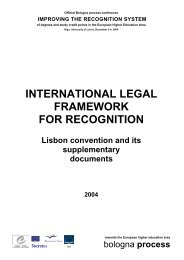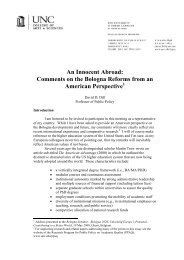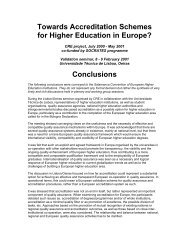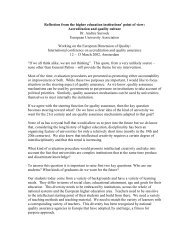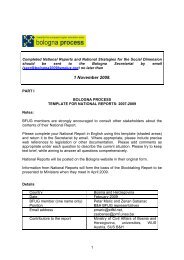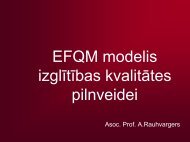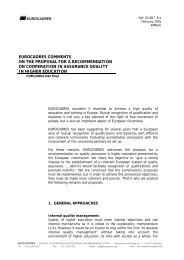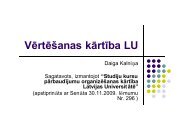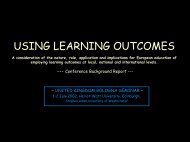EUA Survey Of Master Degrees In Europe - European University ...
EUA Survey Of Master Degrees In Europe - European University ...
EUA Survey Of Master Degrees In Europe - European University ...
Create successful ePaper yourself
Turn your PDF publications into a flip-book with our unique Google optimized e-Paper software.
• Lifelong <strong>Master</strong>: used in some systems to designate second cycle provision delivered quiteseparately from the Consecutive <strong>Master</strong>• Professional <strong>Master</strong>: used in binary systems to distinguish the <strong>Master</strong> awarded by non-universityHEIs from the university-based <strong>Master</strong>The ‘<strong>Master</strong>’ designationAfter nearly a decade of Bologna usage, the <strong>Master</strong> and its variants are well established in <strong>Europe</strong>anHE. Although new in many instances, the term has a historical resonance, harking back to themedieval Magister qualification, which is still the official title in some systems. <strong>In</strong> a few countriesother designations are current. The Holy See has retained the licenza. The Greek metaptychiakodiploma eidikefsis is unsurprisingly pre-latinate. But these, with the Danish kandidat and the Turkishyüksek lisans, are the only major exceptions.To cross any frontier, in a tour of the 46 Bologna countries, is nevertheless to encounter a differentshade of meaning, even where the English word ‘<strong>Master</strong>’ is used. It is a mistake to assume that theterm universally conforms to the British definition. The English (with the Welsh and Northern Irish),the Irish and the Scottish HE systems are a few among many and have no statutory pre-eminence.<strong>In</strong> any case, they speak of the <strong>Master</strong>s, or the <strong>Master</strong>’s, rather than the <strong>Master</strong>.Terminology is never neutral and context is all-important. The Association pour l’emploi des cadresreported in 2007 that the introduction of the term <strong>Master</strong> by French universities had been doublybeneficial. Not only had it shed the sense of incompletion carried by the maîtrise, it had also achieved– at least in the eyes of employers – parity of esteem with the <strong>Master</strong> (and the Mastère spécialisé)offered by the écoles de commerce and the grandes écoles.This report will use the term ‘<strong>Master</strong>’. <strong>In</strong> doing so, it marks its line of descent from the influential‘<strong>Survey</strong> on <strong>Master</strong> <strong>Degrees</strong> and Joint <strong>Degrees</strong> in <strong>Europe</strong>’, compiled for <strong>EUA</strong> by Christian Tauch andAndrejs Rauhvargers in 2002.What is the Bologna <strong>Master</strong>?• Normally carrying ECTS 90-120, of which at least 60 should be at <strong>Master</strong> level• Typical duration of one to two full-time equivalent years• Disciplinary content consistent with generic level descriptors• Curriculum design and pedagogy defined by learning outcomes• A recognised point of entry to the <strong>Europe</strong>an labour marketTen years after the Bologna Declaration of 1999, what stage of development has the Bologna<strong>Master</strong> reached? At the very least, it is specifiable in terms of its location in the second cycle, itsbandwidth in the <strong>Europe</strong>an Credit Transfer and Accumulation System [ECTS], its level descriptors,and its typical duration in full-time equivalent years. It is recognisable – at least to the professionals,agencies, institutions and governments active in higher education.However, it has yet to be fully implemented. It has still to achieve a stable <strong>Europe</strong>an profile in termsof pedagogy, labour market relevance, research-relatedness, funding and finance. It lacks sucha profile, partly because of the persistence of strong pre-Bologna traditions in certain countries,partly because in many others new legislation has not yet delivered a complete portfolio of up-andrunningpostgraduate programmes, and partly because the <strong>Master</strong> has to respond to the imperativeof lifelong accessibility.Its classical delivery mode and function, based on full-time attendance in a single higher educationinstitution [HEI], linking sequentially with Bachelor and with doctorate, is no longer the presumed13



